
An Active Member of the Ottawa Field Naturalists' Club
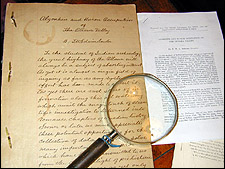  .W. Edwin Sowter's thirst for the past seems to have been very intricately woven into the activities of and his participation in the Ottawa Field Naturalists' Club. The principal areas of interest of this club, which was closely related to the Ottawa Literary and Scientific Society, itself heir of the Ottawa Natural History Society and the Bytown Mechanics Institute and Athenaeum, centered primarily around geology and botany. In fact, some of its most active members were highly respected scholars in these same fields and many were employees of the Geological Survey of Canada. One prominent member was Henri-Marc Ami, a well-respected geologist only two years older than Sowter who would go on to conduct archaeological research on the Palaeolithic and Neolithic of southern France. T.W. Edwin Sowter's application for membership in the Ottawa Field Naturalists' Club was accepted March 30, 1881. .W. Edwin Sowter's thirst for the past seems to have been very intricately woven into the activities of and his participation in the Ottawa Field Naturalists' Club. The principal areas of interest of this club, which was closely related to the Ottawa Literary and Scientific Society, itself heir of the Ottawa Natural History Society and the Bytown Mechanics Institute and Athenaeum, centered primarily around geology and botany. In fact, some of its most active members were highly respected scholars in these same fields and many were employees of the Geological Survey of Canada. One prominent member was Henri-Marc Ami, a well-respected geologist only two years older than Sowter who would go on to conduct archaeological research on the Palaeolithic and Neolithic of southern France. T.W. Edwin Sowter's application for membership in the Ottawa Field Naturalists' Club was accepted March 30, 1881.
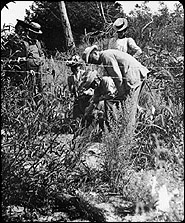 That the young Sowter became involved in the Club's activities is clear. In March of 1886, he was appointed one of the leaders of the Geology branch. These leaders would help organize the geological content of the field outtings and interpret various features during these excursions:"The duties of these leaders consist not only in taking charge of working parties at the excursions and sub-excursions held during the season, and in preparing the reports of the several branches, but also in assisting any person who desires to take up work in any branch" (Library and Archives Canada, R5475-0-0-E ). In 1899, Sowter, along with H.B. Small and J. Ballantyne was appointed leader of the Archaeology branch upon its initial creation, although it is important to point out that this was not the first time that the club had taken an interest in archaeological matters. In fact, in 1883, during an excursion to Casselman, an archaeological site there was the focus of the group's attention (a short note published on June 23, 1883 in The Citizen describes this event) and warranted a small exhibit of artefacts found on that occasion at the monthly meeting of January 17, 1884 where "Specimens of Indian pottery found at Casselman were
exhibited in connection with the report. The night being very stormy the attendance was smaller than it would otherwise have been, but about 30-40 persons were present". That the young Sowter became involved in the Club's activities is clear. In March of 1886, he was appointed one of the leaders of the Geology branch. These leaders would help organize the geological content of the field outtings and interpret various features during these excursions:"The duties of these leaders consist not only in taking charge of working parties at the excursions and sub-excursions held during the season, and in preparing the reports of the several branches, but also in assisting any person who desires to take up work in any branch" (Library and Archives Canada, R5475-0-0-E ). In 1899, Sowter, along with H.B. Small and J. Ballantyne was appointed leader of the Archaeology branch upon its initial creation, although it is important to point out that this was not the first time that the club had taken an interest in archaeological matters. In fact, in 1883, during an excursion to Casselman, an archaeological site there was the focus of the group's attention (a short note published on June 23, 1883 in The Citizen describes this event) and warranted a small exhibit of artefacts found on that occasion at the monthly meeting of January 17, 1884 where "Specimens of Indian pottery found at Casselman were
exhibited in connection with the report. The night being very stormy the attendance was smaller than it would otherwise have been, but about 30-40 persons were present".
In addition to field excursions, the Club also held public meetings where scholarly talks were given. Sowter, evidently following some time of data accumulation, was a frequent lecturer to the Club. Here are some of his titles:
February 21, 1899 "The Archaeology of Lake Deschenes"
March 6, 1900 "Traditional History of some of the Indian inhabitants of the vicinity of Lake Des Chênes"
February 26, 1901 "Prehistoric Camping Grounds along the Ottawa River"
Regarding this last lecture, a notice which appeared in the Ottawa Citizen the next day indicated that:
"Mr. Sowter pointed out that sufficient evidence had been advanced to prove beyond a doubt that the Deschenes Lake vicinity had at one time been an Indian camping ground. Indian relicts in the form of flint arrowheads, stone tomahawks and various instruments and articles of pottery had been found in this locality. Similar evidences of the presence of the redman had been found at Tetreauville and at other points above Aylmer. This paper brought forth considerable comment and was the subject of some discussion."
From the titles of his lectures, it is clear that Edwin Sowter used these lectures as a basis for refining his thoughts on archaeological matters and to further refine them into articles (follow this link to view Sowter's archaeological publications). In fact, two of the titles listed above are the very same as extensive articles published by Sowter either the same year or the next. One could presume that discussions held following his lectures as well as feedback received from the eminent scholars who were in attendance, would be carefully folded into his manuscripts and published with the knowledge that he had withstood the careful scrutiny of leading scientists. In at least one instance, he sought advice outside the region, writing to David Boyle at the Provincial Museum in Toronto (read this 1908 letter).
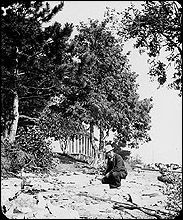 Finally, the greatest moment of Sowter's time with the Club must have been the General Excursion No.2 of 1899 which took place at Queen's Park, Aylmer. Here, Sowter would be able to show his colleagues, associates and friends, the riches that he had discovered on the shores of the Ottawa within his own home town. Two photographs, both taken by H.-M. Ami, have survived from that St.Jean-Baptiste Day (June 24th) in 1899. In the first, we see T.W. Edwin Sowter crouched down at the back of the active beach of the Ottawa River somewhere in Aylmer examining the sedimentary bedrock exposed by the wave action of Lake Deschènes. Was it here that he had found some of the many artifacts which he described in first archaeological publication Notes on the Antiquities of Lake Deschênes in 1895: Finally, the greatest moment of Sowter's time with the Club must have been the General Excursion No.2 of 1899 which took place at Queen's Park, Aylmer. Here, Sowter would be able to show his colleagues, associates and friends, the riches that he had discovered on the shores of the Ottawa within his own home town. Two photographs, both taken by H.-M. Ami, have survived from that St.Jean-Baptiste Day (June 24th) in 1899. In the first, we see T.W. Edwin Sowter crouched down at the back of the active beach of the Ottawa River somewhere in Aylmer examining the sedimentary bedrock exposed by the wave action of Lake Deschènes. Was it here that he had found some of the many artifacts which he described in first archaeological publication Notes on the Antiquities of Lake Deschênes in 1895:
"Narcisse Noël of Aylmer, in company with the writer, also found some imperfect arrow-heads at this place, which appear to have been rejected by the ancient workmen. For about 100 yards along the shore, between high and low water mark, the rocks are littered with chips and shreds of black flint, which are also washed out of the gravel at high water mark after heavy rains."
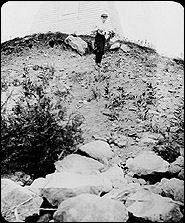 The second photo, again by Ami, shows a young man holding a large object which could be just about anything, including a human skull. He is standing just below the top edge of the steep eroding slope in front of a lighthouse on Lighthouse Island. It was from here that H.-M. Ami, on the day of the Ottawa Field Naturalists' Club excursion (at least that is the date on a browned piece of paper which accompanies skeletal fragments in the Lighthouse Island collections of the Canadian Museum of Civilization), collected human remains, many of them coated with read ochre. That this island was a burial ground of some antiquity had also been noted by Sowter in his 1895 article and repeated in later publications with much greater detail (see Algonkin and Huron Occupation of the Ottawa Valley, 1909 for example): The second photo, again by Ami, shows a young man holding a large object which could be just about anything, including a human skull. He is standing just below the top edge of the steep eroding slope in front of a lighthouse on Lighthouse Island. It was from here that H.-M. Ami, on the day of the Ottawa Field Naturalists' Club excursion (at least that is the date on a browned piece of paper which accompanies skeletal fragments in the Lighthouse Island collections of the Canadian Museum of Civilization), collected human remains, many of them coated with read ochre. That this island was a burial ground of some antiquity had also been noted by Sowter in his 1895 article and repeated in later publications with much greater detail (see Algonkin and Huron Occupation of the Ottawa Valley, 1909 for example):
"Some years ago a quantity of human bones was found buried in the sand on the Lighthouse Island just above Aylmer, which the late Dr. C. M. Church, to whom they were presented, regarded as typical of the North American Indian."
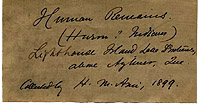 |
The Canadian Museum of Civilization holds human remains which were reportedly found at Aylmer Island, also known as Lighthouse Island. Two very old hand written labels provide the basic provenance information for the collections and one bears the date of the O.F.N.C. General Excursion No.2 held June 24, 1899. |
 |
|

 The second photo, again by Ami, shows a young man holding a large object which could be just about anything, including a human skull. He is standing just below the top edge of the steep eroding slope in front of a lighthouse on Lighthouse Island. It was from here that H.-M. Ami, on the day of the Ottawa Field Naturalists' Club excursion (at least that is the date on a browned piece of paper which accompanies skeletal fragments in the Lighthouse Island collections of the Canadian Museum of Civilization), collected human remains, many of them coated with read ochre. That this island was a burial ground of some antiquity had also been noted by Sowter in his 1895 article and repeated in later publications with much greater detail (see Algonkin and Huron Occupation of the Ottawa Valley, 1909 for example):
The second photo, again by Ami, shows a young man holding a large object which could be just about anything, including a human skull. He is standing just below the top edge of the steep eroding slope in front of a lighthouse on Lighthouse Island. It was from here that H.-M. Ami, on the day of the Ottawa Field Naturalists' Club excursion (at least that is the date on a browned piece of paper which accompanies skeletal fragments in the Lighthouse Island collections of the Canadian Museum of Civilization), collected human remains, many of them coated with read ochre. That this island was a burial ground of some antiquity had also been noted by Sowter in his 1895 article and repeated in later publications with much greater detail (see Algonkin and Huron Occupation of the Ottawa Valley, 1909 for example):

 .W. Edwin Sowter's thirst for the past seems to have been very intricately woven into the activities of and his participation in the Ottawa Field Naturalists' Club. The principal areas of interest of this club, which was closely related to the Ottawa Literary and Scientific Society, itself heir of the Ottawa Natural History Society and the Bytown Mechanics Institute and Athenaeum, centered primarily around geology and botany. In fact, some of its most active members were highly respected scholars in these same fields and many were employees of the Geological Survey of Canada. One prominent member was Henri-Marc Ami, a well-respected geologist only two years older than Sowter who would go on to conduct archaeological research on the Palaeolithic and Neolithic of southern France. T.W. Edwin Sowter's application for membership in the
.W. Edwin Sowter's thirst for the past seems to have been very intricately woven into the activities of and his participation in the Ottawa Field Naturalists' Club. The principal areas of interest of this club, which was closely related to the Ottawa Literary and Scientific Society, itself heir of the Ottawa Natural History Society and the Bytown Mechanics Institute and Athenaeum, centered primarily around geology and botany. In fact, some of its most active members were highly respected scholars in these same fields and many were employees of the Geological Survey of Canada. One prominent member was Henri-Marc Ami, a well-respected geologist only two years older than Sowter who would go on to conduct archaeological research on the Palaeolithic and Neolithic of southern France. T.W. Edwin Sowter's application for membership in the 


